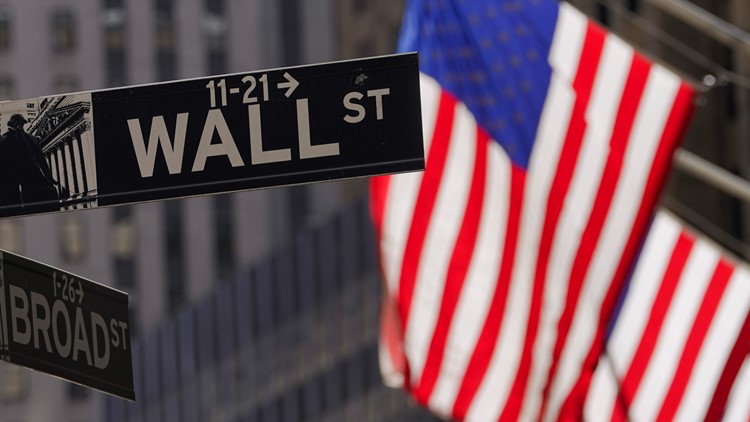NEW YORK — Good news on the economy remains bad news for Wall Street, as stocks fell sharply Friday on worries a still-strong U.S jobs market may actually make a recession more likely.
The S&P 500 ended 2.8% lower after briefly dropping 3.3% as traders weighed a government report showing employers hired more workers last month than economists expected. The Dow Jones Industrial Average fell 2.1% and the Nasdaq composite lost 3.8%.
Wall Street is worried the Federal Reserve could see that as proof the economy has yet to slow enough to get inflation under control. That could clear the way for the Fed to continue hiking interest rates aggressively, something that risks causing a recession if done too severely.
“The employment situation is still good and that might be a little frustrating to the Fed,” said Brian Jacobsen, senior investment strategist at Allspring Global Investments. “The Fed thinks we need more people unemployed in order to make sure inflation comes down and stays down.”
Stocks have tumbled over 20% from records this year on worries about inflation, interest rates and the possibility of a recession.
The major indexes managed to notch a gain for the week, thanks to a powerful but short-lived rally Monday and Tuesday after some investors squinted hard enough at some weaker-than-expected economic data to suggest the Fed may take it easier on rate hikes. But Friday’s jobs report may have dashed such hopes for a “pivot” by the Fed. It's a pattern that has been repeated several times this year.
“For for a lot of this a year, there really has been a degree of false optimism among many investors that the Fed would would tap the brakes and pivot sooner than they’ve been telling us they will for quite some time," Bill Merz, head of capital market research at U.S. Bank Wealth Management.
"The market is increasingly coming to terms with, albeit gradually, that the Fed is highly unlikely to pivot in the near-term as some have been hoping for.”
Employers added 263,000 jobs last month. That’s a slowdown from the hiring pace of 315,000 in July, but it’s still more than the 250,000 that economists expected.
Also discouraging for investors was that the unemployment rate improved partly for the wrong reasons. Among people who aren’t working, fewer than usual are actively looking for jobs. That’s a continuation of a longstanding trend that could keep upward pressure on wages and inflation.
“We are not out of the woods yet, but should be getting closer as the impact of aggressive policy starts to take hold,” said Matt Peron, director of research at Janus Henderson Investors.
By hiking interest rates, the Fed is hoping to slow the economy and jobs market. The plan is to starve inflation of the purchases needed to keep prices rising even further. The Fed has already seen some effects, with higher mortgage rates hurting the housing industry in particular. The risk is that if the Fed goes too far, it could squeeze the economy into a recession. In the meantime, higher rates push down on prices for stocks, cryptocurrencies and other investments.
“Everything hinges on inflation at this point,” said Peter Essele, head of portfolio management for Commonwealth Financial Network. “We do think its going to moderate over the next few quarters.”
Altogether, many investors see Friday's jobs data keeping the Fed on track to hike its overnight rate by three-quarters of a percentage point next month. It would be the fourth such increase, which is triple the usual amount, and bring the rate up to a range of 3.75% to 4%. It started the year at virtually zero.
Crude oil, meanwhile, had its biggest weekly gain since March. Benchmark U.S. crude jumped 4.7% to settle at $92.64 per barrel Friday. Brent crude, the international standard, rose 3.7% to settle at $97.92.
They’ve shot higher because big oil-producing countries have pledged to cut production in order to keep prices up. That should keep the pressure up on inflation, which is still near a four-decade high but hopefully moderating.
The rise for crude helped stocks of oil-related companies to be among Wall Street's very few to rise Friday. Oilfield services provider Halliburton climbed 2%.
Stocks of technology companies led the way in the opposite direction. They've been among the hardest hit by this year's rising rates, which most hurt investments seen as the riskiest, most expensive or having to make investors wait the longest for big growth.
Microsoft slumped 5.1%, and Amazon fell 4.8%.
All told, more than 90% of stocks in the S&P 500 closed lower Friday. The index fell 104.86 points to 3,639.66. It ended with a 1.5% gain for the week, its first weekly gain in four weeks.
The Dow dropped 630.15 points to 29,296.79, while the Nasdaq lost 420.91 points to close at 10,652.40.
Smaller company stocks also gave up more ground. The Russell 2000 index fell 50.36 points, or 2.9%, at 1,702.15.
Beyond higher interest rates, analysts say the next hammer to hit stocks could be a potential drop in corporate profits. Companies are contending with high inflation and interest rates eating into their earnings, while the economy slows.
Advanced Micro Devices fell 13.9% after it warned revenue for its latest quarter is likely to come in at $5.6 billion, below its prior forecasted range of $6.5 billion to $6.9 billion. AMD said the market for personal computers weakened significantly during the quarter, hurting its sales.
Levi Strauss fell 11.7% after it cut its financial forecast for its fiscal year. It cited the surging value of the U.S. dollar against other currencies, which weakens the dollar value of sales made abroad, as well as a more cautious outlook on economies across North America and Europe.
Treasury yields rose immediately after the jobs report’s release, though they wobbled a bit afterward. The yield on the 10-year Treasury, which helps set rates for mortgages and other loans, climbed to 3.88% from 3.83% late Thursday.
The two-year yield, which more closely tracks expectations for Fed action, rose to 4.30% from 4.26%. Earlier in the morning, it climbed above 4.33% and was near its highest level since 2007.



